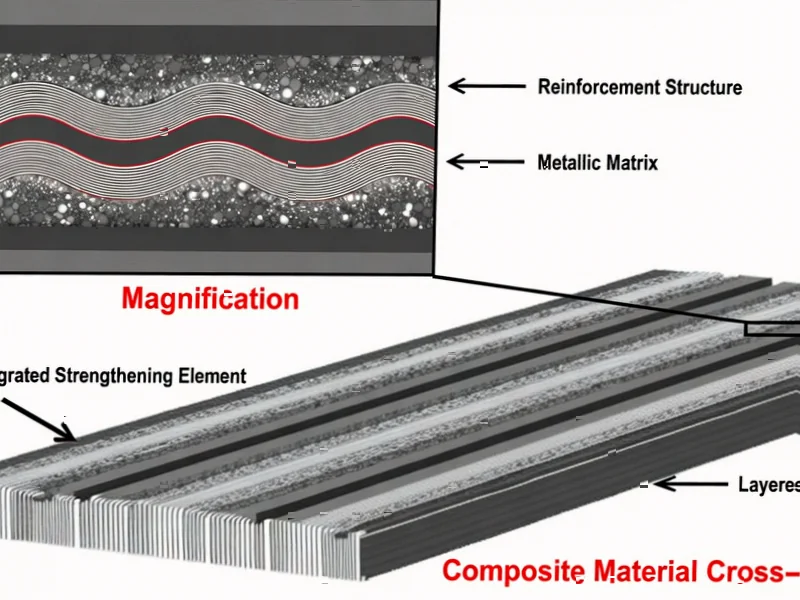According to Nature, researchers have developed reinforced concrete-inspired aluminum matrix composites (RC-AMCs) that achieve dramatic strength improvements through multi-scale reinforcement architecture. The composites combine 3D-printed titanium alloy scaffolds with micrometer-sized AlTi particles and nano-scale precipitates, delivering yield strength increases from 103 MPa to over 537 MPa while maintaining 335 MPa strength at 500°C temperatures. This breakthrough suggests new possibilities for lightweight, high-temperature structural materials.
Table of Contents
Understanding the Multi-Scale Reinforcement Breakthrough
The fundamental innovation here lies in mimicking reinforced concrete’s hierarchical structure at multiple length scales. Traditional aluminum matrix composites typically rely on single-scale reinforcement – either particles, fibers, or laminates – which creates inherent limitations in strength, ductility, and manufacturability. The RC-AMC approach integrates three distinct reinforcement mechanisms: millimeter-scale titanium alloy struts acting as macroscopic reinforcement similar to titanium alloy rebar, micron-scale AlTi particles providing intermediate strengthening, and nano-scale precipitates offering the finest level of reinforcement. This multi-scale approach overcomes the traditional trade-off between high reinforcement content and material porosity that has plagued conventional composite manufacturing.
Critical Analysis of Manufacturing and Scaling Challenges
While the mechanical results are impressive, the manufacturing complexity raises significant questions about commercial viability. The process combines additive manufacturing of titanium scaffolds with micro-casting of aluminum around these structures – two technically demanding processes that must be perfectly synchronized. Maintaining the reported sub-0.5% porosity requires exceptional process control that may be difficult to achieve consistently in industrial settings. The anisotropic mechanical properties revealed by different loading directions (A, B, and C) also present design challenges for real-world applications where multi-directional loading is common. The research shows exceptional compressive strength, but comprehensive data on tensile properties, fatigue resistance, and fracture toughness – all critical for structural applications – remain to be fully characterized.
Industry Impact and Application Potential
This technology could disrupt several high-value manufacturing sectors if scaling challenges can be overcome. Aerospace stands to benefit significantly, where the combination of high specific strength and maintained performance at elevated temperatures addresses key limitations of current aluminum alloys. The automotive industry could leverage these materials for high-performance components in electric vehicle powertrains where weight reduction and thermal management are critical. The demonstrated yield strength of 335 MPa at 500°C is particularly remarkable since conventional aluminum alloys essentially lose all structural integrity at these temperatures. The ability to maintain strength while reducing weight could enable more efficient thermal management systems and higher operating temperatures across multiple industries.
Realistic Outlook and Development Timeline
The path from laboratory demonstration to commercial application will likely take 5-10 years given the manufacturing complexity and need for comprehensive materials qualification. The most immediate applications will probably emerge in niche aerospace and defense components where performance justifies higher costs. The unusual temperature-dependent twinning behavior in AlTi particles, where crystal twinning increases rather than decreases with temperature, represents both an opportunity and a fundamental materials science puzzle that requires deeper understanding. As additive manufacturing costs continue to decline and process control improves, we may see gradual adoption in premium automotive and specialized industrial applications. The true test will come when independent research groups replicate these results and when the materials demonstrate long-term stability under realistic service conditions.



